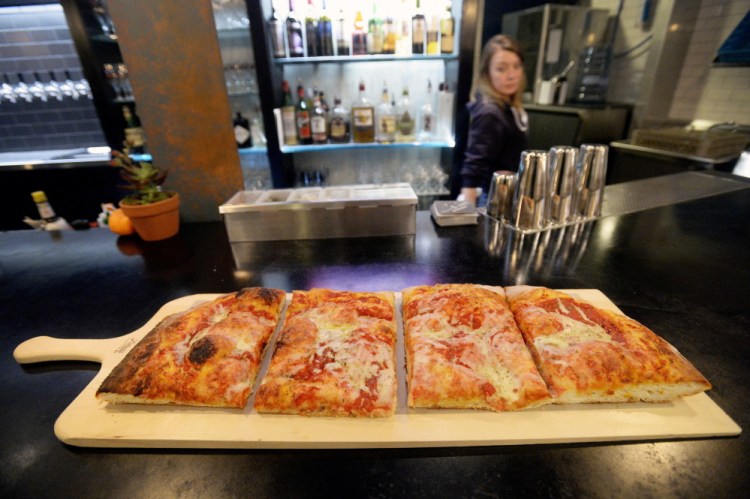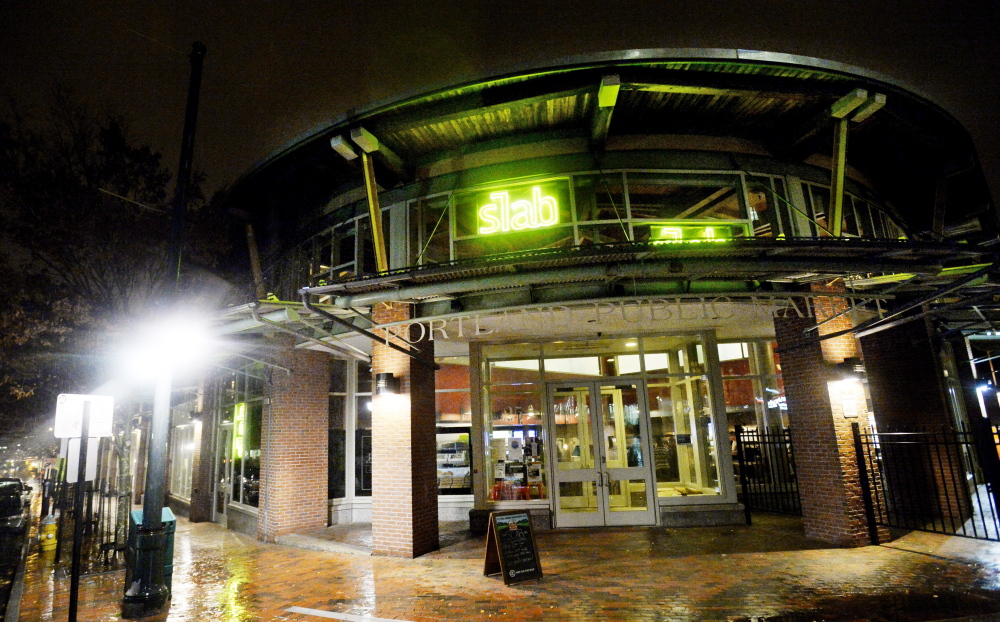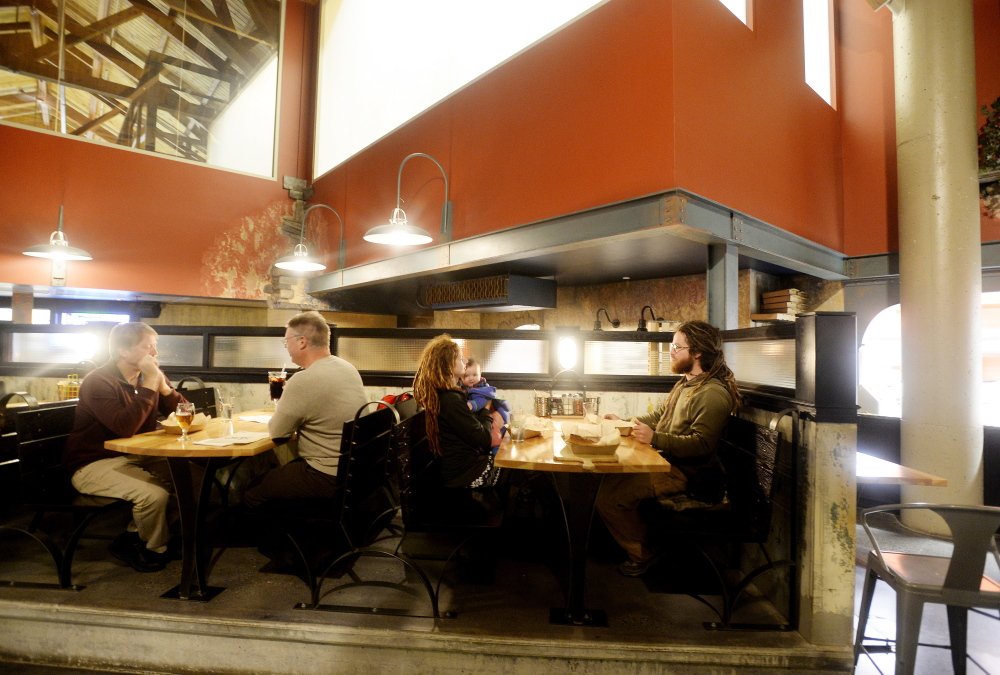Dinner at Slab, chef Stephen Lanzalotta’s new restaurant in the former Portland Public Market, sounds a lot like a rousing tent revival. In between bites of the kitchen’s signature Sicilian street food, customers cry out and murmur with pleasure: “Oh my God, oh my God, oh my God” (that was a friend at my table), followed by “Lord, this is good,” “I swear,” and, with the arrival of another baker’s peel of entrees, “Please – save me.” And every ecstatic compliment – every accolade for Slab’s intensely flavored, carbohydrate-laced menu – is deserved.
You smell the wizardry here before you taste it. Step inside the glass doors on Preble Street and the scents rise to meet you: garlic, tomatoes, yeast, cheese, and hints of citrus and spice. They’re the building blocks upon which much of the menu is constructed, from pizzas and open-faced sandwiches (called “shoes” because the literal translation of Italian sandwich bread is “slipper”) to bread salads and pastry pockets.
“Ninety percent of what we serve at Slab is actually traditional Sicilian food made with the most traditional ingredients,” Lanzalotta says, “but the combinations of flavors and ingredients make it seem exotic and extraordinary for Americans. I love the freedom that this food – with its North African and Middle Eastern influences – gives me to experiment. It’s that fusion that gives us our niche.”
Take Ceci alla Sicilia, the zesty hummus appetizer ($6) that leads the menu. Mounded atop slices of purple onion and sprigs of dressed parsley, the chickpeas are chunky and aromatic, spiced with sage, orange peel, cinnamon, saffron and turmeric, and sprinkled with flakes of crushed red pepper. This is not your mother’s hummus. With my friend digging in and chanting her “oh my God” mantra, I had my own epiphany. Who knew hummus could taste, well, refreshing? These chick peas were fresh and bright, enhanced by a drizzle of fruity olive oil. Surprising and satisfying on its own, the hummus was elevated to supernal when slathered (using one of Slab’s snazzy, Dwell-style wooden table knives) onto a wedge of toasted pizza bread. Suddenly, I wasn’t just interested, I was famished.
The waitress, who could see (and hear) that she had a table of appreciative customers, let us in on a secret: “We’re known for our slabs and pizzas, but the specials on the other side of the menu are where it’s at.” Following her lead, we ordered a Hand Slab ($6), the 1-pound Sicilian slice that Lanzalotta introduced when he worked at Micucci’s in 2007, as well as an open-faced Shoe and two specials.
If you haven’t yet tried a Slab, skip breakfast – well, skip breakfast and lunch – and add one to your must-eat list. It’s an enormous and chewy celebration of bright, sweet tomato sauce, melted mozzarella and provolone, and bread. A billowing pillow of impeccably salted bread with a crunchy base, that is. The Slab had me muttering my own “oh my Gods” and disdaining the very idea of ever ordering, or even muttering, “thin crust” again. It’s no wonder Lanzalotta brought the Slab with him to his new venture and built his menu around it.
Slightly dazed, we turned to the “shoes”: a crumbled sausage and broccoli rabe sandwich ($9) from the specials menu, and a caponata sandwich ($9) listed on the regular menu.
For the former, Lanzalotta combines pungent rapidly cooked rabe with morsels of spicy pork and melted mozzarella and provolone, plus a wedge of lemon that enhances the sharp, slightly bitter and mustardy-tasting greens. The shoe was good on its own, but dipping forkfuls into a container of “Slab sauce” – the same tomato reduction that tops the best-selling pizza – made it exceptional.
The Caponata Shoe was equally satisfying. This time the kitchen topped the pizza bread with a hearty stew of roasted eggplant, onions, olives, capers and celery – darkly colored, slightly sweet, slightly sour and meltingly delicious. The Italians call the contrasting flavors of sweet and sour “agrodolce,” and it’s an essential characteristic of many Sicilian dishes. (Lanzalotta says the highest compliment he has received came from an Italian couple who couldn’t believe he’d never lived in Sicily or even crossed the Atlantic. “But you understand agrodolce?!” they marveled.) Scooping spoonfuls of caponata that had tumbled off back onto the wedge of bread, I didn’t want to finish this dish. I wanted to bathe in it.
Perhaps inevitably, a panzanella bread salad ($9) paled beside other more piquant entrees. It was attractive, served with a translucent slice of English cucumber skewered through like a ribbon, but the same bread that tastes unforgettable paired with briny olives or spicy sausage, recedes when covered with simple salad greens.
So skip the salad and leave room for a dessert: ricciarelli, the traditional, flourless almond cookies ($2.50 each) from Tuscany that have a place on Sicilian tables as well. They are intensely moist, densely nutty confections with a velvety interior and a paper-thin sugary crust. Think almond torte on steroids or marzipan gone wild. As Lanzalotta said, “Ricciarelli really are having your cake and eating it, too.”
You may encounter a few glitches at Slab. The whimsical wooden spoons offered with cannoli ($6) feel a bit splintery on the tongue, and the torn lengths of brown paper used as place mats get oil- and sauce-stained in short order. But the menu trumpets that everything at Slab is “biodegradable and recyclable,” and the owners (Lanzalotta and Emily Kingsbury and Jason Loring, Tobey Moulton and Matt Moran of Nosh) deserve kudos for thinking green. Besides, these are quibbles at a restaurant where food and service are outstanding and the look of the place – gritty industrial loft meets romantic Sicilian hill town – is unusual and appealing.
We were spent by the time we waddled out the doors and onto the pavement of Preble Street. Maybe it was the cookies. Maybe it was the angelic wait staff. Probably it was the gluten. Still, I can’t remember the last time I enjoyed such a transcendent feast of street food in a sit-down setting. I felt as if I’d died and gone to heaven. Only this time, I’ll be back.
James H. Schwartz has covered food, travel and architecture for The Washington Post, Downeast, Coastal Living and Southern Living magazines for more than 30 years. Long a commuter between Portland and Washington, D.C., he retired from his job as vice president at the National Trust for Historic Preservation in 2013 and relocated to Maine.
Send questions/comments to the editors.





Comments are no longer available on this story